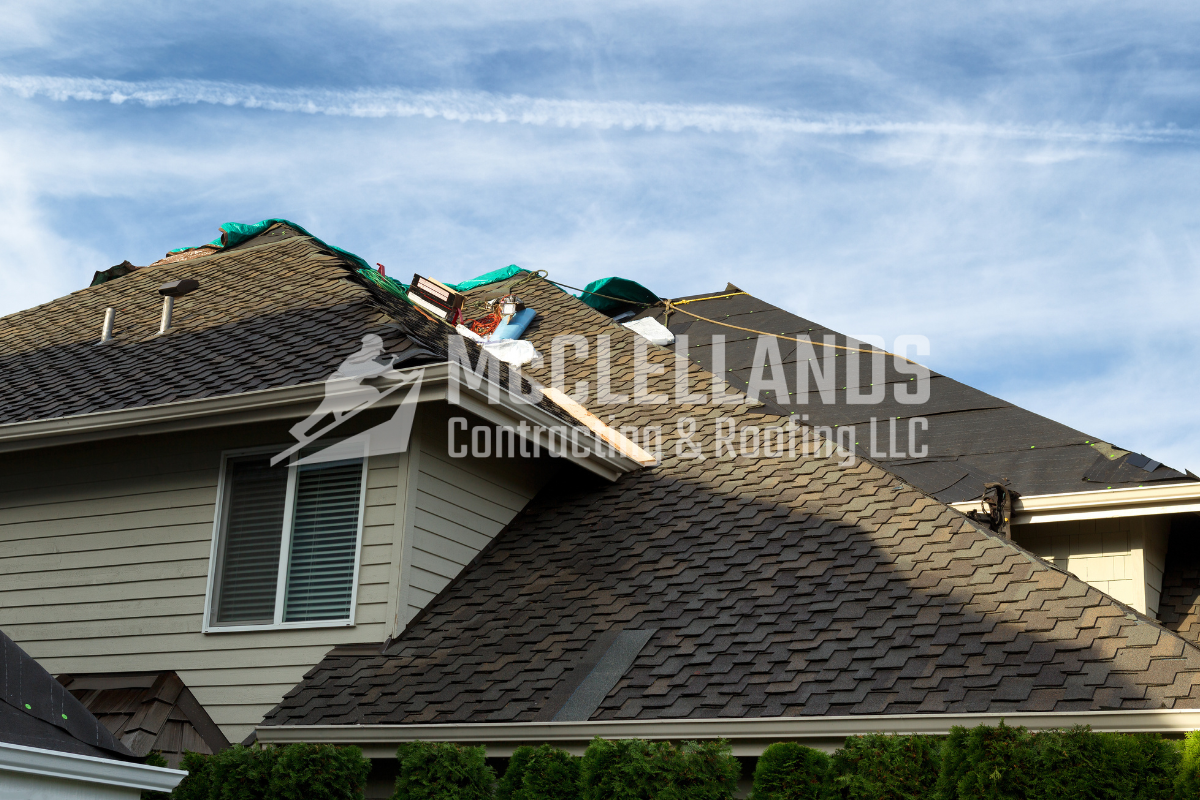
Replacing your entire roof is not an easy or quick job, it takes time and expertise. If you’re looking to replace your roof due to major wear and tear, it’s important to learn about the process before getting started.
At McClellands Roofing and Replacement, we understand the importance of roof replacement projects, so we’ve created this complete guide. From the signs that your roof needs a replacement to the estimated cost, we’ve compiled all the important information for you in this blog post.
👉🏼 Signs Your Roof Needs A Replacement
How do you know when it’s time for a roof replacement versus a simple repair? Here are some key signs to watch out for:
⏺️ Shingles are cracked, curled, buckling, or missing in multiple areas.
⏺️ Sunlight coming through the roof boards in the attic.
⏺️ Widespread water staining on ceilings or exterior walls.
⏺️ The roof is over 20 years old (typical asphalt shingle lifespan).
⏺️ Poor insulation or energy efficiency.
If you spot multiple red flags like these, it’s likely more cost-effective to opt for a full roof replacement rather than repairs.
👉🏼 Things To Consider Before Replacing Your Roof
There are certain important factors you need to consider before replacing your roof.
1. Roof Size & Slope
A larger roof area or complex slopes and angles will impact labor requirements and material costs. Roofs with easier access also tend to be more affordable to replace. Steep roofs or multi-level homes present additional safety challenges that require more time and equipment, driving up installation expenses.
2. Local Climate
Areas prone to severe weather, such as high winds, heavy snow loads, hail storms, or wildfires, may require specialized underlayment or fire-resistant roofing options to meet local building codes. For instance, impact-resistant shingles are ideal for hail-prone regions to prevent cracking or granule loss.
3. Ventilation & Insulation
Replacing your roof is the ideal time to upgrade attic ventilation and insulation for maximum energy efficiency in your new system. Proper venting and insulation allow your home to maintain comfortable temperatures, reducing strain on your HVAC system and saving money on utility bills.
4. Budget
In general, you can expect to pay anywhere between $6,000 and $80,000 for a standard roof replacement. However, larger homes or premium materials can easily exceed $20,000 or more for a full roof replacement project.
5. Insurance Claim
Most home insurance policies cover roof damage from falling objects, fires, hailstorms, lightning strikes, smoke, heavy ice/snow loads, high winds, and vandalism. Insurance adjusters can deny claims if the damage type isn’t covered or if exclusions apply, like lack of proper roof maintenance, age-related wear, etc. To avoid surprises, thoroughly understand what causes of roof damage are and aren’t protected under your insurance.

👉🏼 Estimated Cost To Replace A Roof
Speaking of budget, let’s look at some typical factors that will impact the final roof replacement cost:
Roof Type
When you estimate the average cost to replace your roof, the type of material is the major factor that decides the estimated cost. Various types of roofs have different requirements that can affect your total budget.
Here is a list of average cost estimations for each type of roof for a 2,000-square foot home:
| Roofing Material | Cost Range |
| Asphalt Shingles | $8,000 to $17,000 |
| Slate | $19,000 to $52,000 |
| Cedar Shakes | $14,000 to $32,000 |
| Galvanized Steel | $14,000 to $30,000 |
| Concrete Tiles | $14,000 to $40,000 |
| Aluminum | $16,000 to $34,000 |
| Copper | $42,000 to $80,000 |
| Clay Tiles | $22,000 to $50,000 |
Labor
Roofing contractors typically charge $40 to $60 per hour for labor, including tear-off, underlayment installation, and material installation. Expect labor rates to be higher for complex roof designs.
Roof Size
Larger roofs will inherently require more materials and labor for the installation, making the project more expensive compared to smaller homes.
Additional Costs
⏺️ Structural repairs, skylights, chimneys, permits, gutters, and other customizations will increase the overall price accordingly.
⏺️ When budgeting for a roof replacement, be sure to get multiple quotes, as pricing can vary greatly based on location, material choices, and contractor margins. Many companies offer attractive financing options to make this big investment more manageable.
Also Read: How Much Does A New Roof Cost?
👉🏼 Partial Roof Replacement vs. Full Roof Replacement
This comparative table explains when to choose a partial roof replacement or a full roof replacement in detail:
| Full Roof Replacement | Partial Roof Replacement |
| The entire existing roof is torn off and replaced | Only damaged/worn sections are replaced |
| Recommended for roofs nearing the end of their lifespan | Suitable for addressing isolated problem areas |
| Ensures consistent look and performance across the whole roof | Potential for mismatched shingles or styles |
| More invasive and time-consuming process | Quicker and less disruptive project |
| Higher overall material and labor costs | Lower costs than a complete replacement |
| Opportunity to upgrade roofing material or add new features | Limited to repairing with existing roof materials |
| Qualifies for material and labor warranties on the full system | May void warranties on existing components |
| Eliminates any lingering issues or defects from the previous roof | Underlying issues with the overall roof could persist |
| Maximizes the lifespan and ROI of the new roof installation | A temporary solution until full replacement is required |
| Increases home value and curb appeal | Minimal impact on home value or aesthetics |
👉🏼 How Often Should You Replace Your Roof?
The frequency of needing a roof replacement depends primarily on the roofing material and whether previous installations were done properly. Below is a general estimate of the lifespan of common roofing materials:
| Roofing Material | Lifespan Range |
| Asphalt Shingles | 15-30 years |
| Wood Shakes | 20-40 years |
| Concrete/Clay Tiles | 35-50+ years |
| Metal Roof | 40-70 years |
Proper attic ventilation, routine maintenance, and repair of problem areas can help maximize the lifespan of your roof before requiring a full replacement. However, once a roof nears the end of its expected service life, it’s wise to be proactive about replacing it.
Signs of an aging roof system include curling or missing shingles, cracked tiles, persistent leaks, deteriorated flashing, and granule loss exposing the asphalt substrate. At that point, you’ll want to consult roofing contractors for quotes on a timely roof replacement.
👉🏼 How To Replace Your Roof
Roof replacements are typically done in the following steps by professional roofing contractors:
Step 1: In the first step all old roofing materials are carefully removed and properly disposed of, leaving a clean slate.
Step 2: The roof deck will undergo a comprehensive inspection to find any existing problems before the next step.
Step 3: New underlayment and flashing will be installed to create a water-resistant barrier and direct water away.
Step 4: The chosen roofing material will be expertly installed, according to manufacturer guidelines and industry best practices.
Step 5: Proper ventilation and skylights (if desired) will be integrated into the roofing system for optimal airflow.
Step 6: A final inspection will ensure quality standards are met, and the job site will be thoroughly cleaned.
DIY vs. Professional Roof Replacement
Homeowners often wonder whether to take on the project themselves or hire professional roofing contractors. Here’s a look at the key considerations for each approach:
| Professional Roof Replacement | DIY Roof Replacement |
| Ensures proper installation | Satisfaction of doing the work yourself |
| Trained crews follow manufacturer specifications and building codes | Requires specialized safety gear, tools, technical know-how |
| Workmanship guaranteed | Need to acquire/rent ladders, scaffolding, nail guns, etc. |
| Handle cleanup, permitting, and material disposal | Laborious removal and disposal of old materials |
| Higher upfront costs for labor and overhead | Saves on labor costs |
| Provides peace of mind and long-term protection | Risk of mistakes leading to leaks, premature aging, voided warranties |
| Offer various material choices, customizations, and extended warranties | Risks often outweigh potential savings without prior experience |
👉🏼 Essential Points To Maintain Your New Roof
After you have a new roof installed on your home, it’s time to follow some maintenance tips to ensure its durability. Here are some essential points to maintain your roof:
➡️ Get roof inspections yearly to catch issues early
➡️ Clean gutters and downspouts routinely, especially after storms
➡️ Trim back trees with branches hanging over the roof
➡️ Replace any cracked, curled, or missing shingles right away
➡️ Make sure the attic has sufficient ventilation to prevent moisture buildup
➡️ Check and reinforce flashing around chimneys, vents, and skylights
➡️ Remove any growing moss or algae growth from the roof surface
➡️ Avoid pressure washing – use gentler cleaning methods on shingles
Taking care of small issues proactively is key and can help you extend your roof’s lifespan and prevent bigger, costlier repairs down the road.

👉🏼 Call McClellands Contracting and Roofing For Your Roof Replacement In Pittsburgh PA
At McClellands Contracting and Roofing, we take pride in our quality roof replacement services that prioritize durability, style, and most importantly – your satisfaction. When it’s time for a new roof, trust our expertise to protect your biggest investment for decades to come.
Don’t delay an essential roof replacement and risk compromising your home’s structural integrity. Reach out today at (412) 353 5660 to schedule your free roof evaluation and learn more about our competitive pricing, financing options, and top-rated roofing services!




